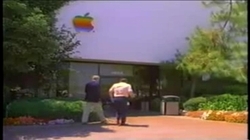|
 Steve Jobs and Apple Computer once built a "factory of the future" in Fremont, California. They spent $20,000,000 and then closed it after just two
years. Today, Apple's net worth is more than Poland. So, what went wrong in 1984? And, what is going right today? Steve Jobs and Apple Computer once built a "factory of the future" in Fremont, California. They spent $20,000,000 and then closed it after just two
years. Today, Apple's net worth is more than Poland. So, what went wrong in 1984? And, what is going right today?
What went wrong was not cheap overseas labor. It was their failure to integrate Marketing Strategy with Manufacturing Strategy. Or, more
likely, Apple failed to even consider the issues of Manufacturing Strategy. Later, when Apple partnered with Foxconn, Apple and Foxconn did
not repeat the earlier mistakes.
What follows is a review of what is publicly known about Apple and Foxconn in the context of Manufacturing Strategy.
Manufacturing & Marketing Strategy
Manufacturing Strategy addresses the question "How to go about fulfilling our manufacturing tasks?" The answer is at a policy level and addresses a range
of issues such as equipment characteristics, plant layout, workflow and people.
As the design of a factory progresses, thousands of decisions are made by engineers, managers, contractors and suppliers. A Manufacturing Strategy guides
them as they make decisions such as:
-
Machine A costs more than machine B but it may be more adaptable to future products. Which to choose?
-
Should we design the floor slab in this area for the light assembly operations originally planned? Or should we
design it for machining and warehouse operations that might be in this area several years from now?
-
Equipment in this area will be sensitive to vibration. The manufacturer says we can set it on a six-inch slab but
should we make the slab thicker to absolutely guarantee the machine will be capable?
-
Should we use conduit wiring (cheaper) or bus duct ( more flexible)?
-
How much space should we allow for purchased parts storage?
Such issues may seem technical, low-level and almost trivial—hardly the domain of top management. But the wrong decisions can have far-reaching effects. And, an accumulation of wrong decisions can saddle a company with a factory or multiple factories that does not meet current market
needs yet is too expensive to replace. It affects long-term competitiveness and, eventually, stock price. These are top management's domain.
|
Apple's Key Manufacturing Task
Apple, from the very beginning has had a marketing and business strategy based on these characteristics:
They have, generally, executed this strategy well over many years—but, that is another story. Our concern here is with the demands this marketing
and business strategy place on a manufacturing system. The most important one or two of these demands become the "Key Manufacturing Tasks."
So what are Apple's key manufacturing tasks and what are their relative priorities?" This question leads back to marketing and product
design.
Flexibility
More than anything else, Apple's marketing strategy requires flexibility in manufacturing. This flexibility comes in several forms
-
New Product Flexibility
-
Volume Flexibility
-
Product Mix Flexibility
Apple's factories
must be able to reconfigure for new products very quickly because of the fast life cycles (New Product Flexibility). The factories must be able to increase production from pilot to maximum demand quickly because of the initial promotions and short life-cycles (volume flexibility). If the factory cannot produce
it probably has lost sales. Since sales forecasts are notoriously inaccurate and new product forecasts even more so, the factory must be prepared for a
landslide, a fizzle and anything in between. Then, as the product life cycle nears its end, the factory must be able to decrease production and prepare for the next new product.
Quality
Apple has a reputation for good quality but quality is not their most important selling point. Good quality is important to Apple's customers because they perceive a risk in purchasing new, innovative unproven products. Once individuals decide that quality is good enough, they buy the products for their innovative features.
Consumers do not want to be stuck with an orphan or a lemon. Because of Apple's spectacular initial promotions, quality must be right in the beginning or
Apple's reputation would be severely damaged.
For Apple, quality is what Terry Hill calls a qualifier. Apple does not need the highest quality in the market, just acceptable quality. A reputation for
poor quality, however, would damage Apple's reputation with disastrous effects on the next new product. Hill calls such qualifiers "Sensitive Order-Losers."
In other words, quality only becomes critically important if it falls below acceptable levels.
Cost
Apple charges a premium price and enjoys high profit margins. This means that, within limits manufacturing cost is not the most important consideration
when designing or operating an Apple factory. Flexibility is far more important.
Next—Apple's Ill-Fated Fremont Factory...
|






Steve Jobs
"Those jobs aren't coming back."
Apple, Inc. has been in the news a lot lately. Partly because of their profitability and stock value; partly because of labor controversy. At Strategos we take no position on the labor controversy or stock price.
We can comment on what little is known publicly about Apple's manufacturing operations—both current operations in China and past operations in the United States. When Steve Jobs told Obama "Those jobs aren't coming back" he was probably correct. But, maybe, they didn't have to leave in the first place.